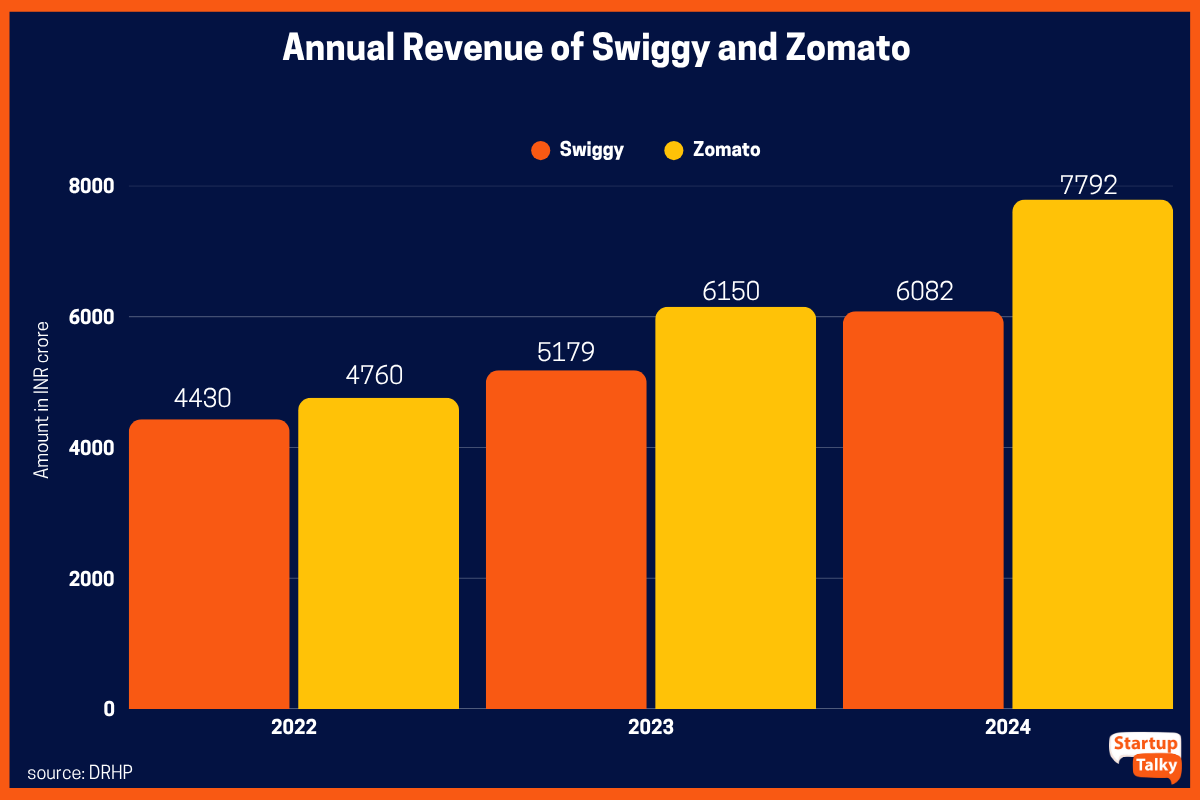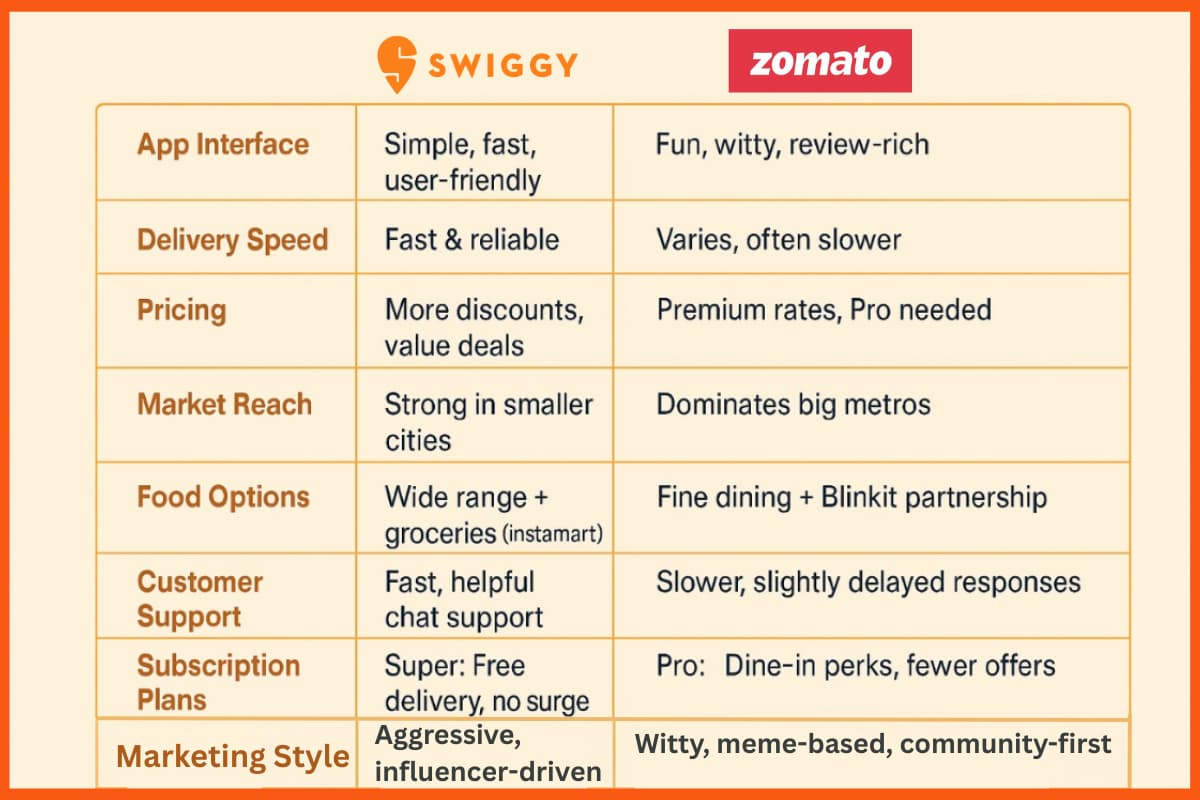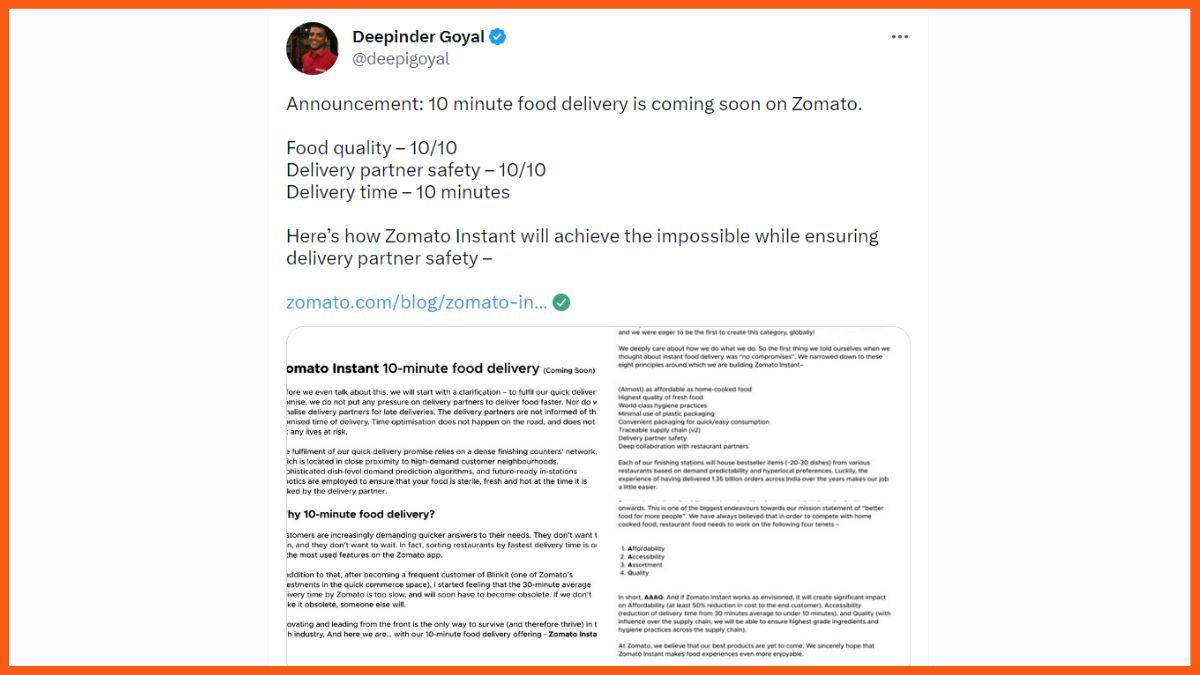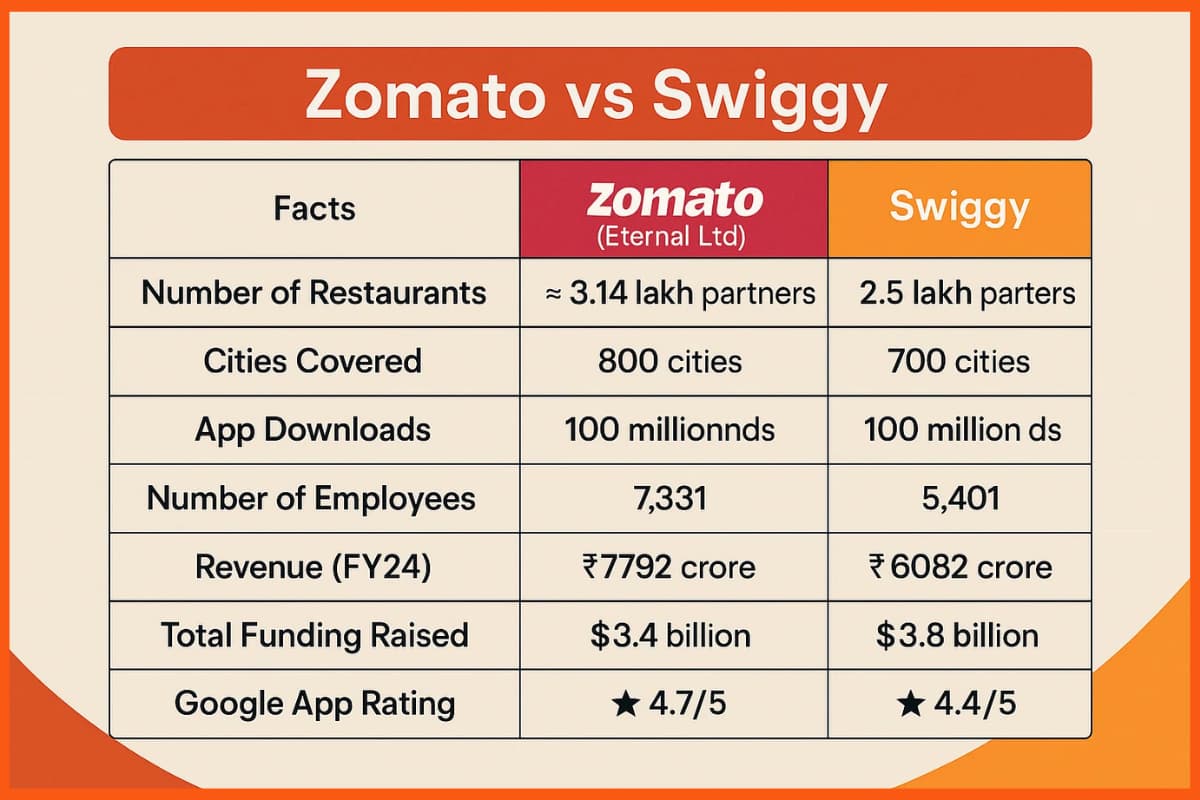People’s eating habits have changed significantly, specifically because of the lockdown. People become more familiar with ordering food online from the convenience of their homes. Two players, Zomato and Swiggy, dominate the Indian food delivery industry.
Food delivery businesses got paced during the lockdown period. According to the research report of the ETC group, Swiggy is the ninth biggest food delivery company in the world, and Zomato is the tenth biggest.
Both these companies are adopting and experimenting with new things to dominate the market. So here we are with the full analysis to let you know who will win the food delivery race.
Food Delivery Industry in India
Innovations of Zomato
Innovations by Swiggy
Figure Overview: Zomato vs Swiggy
Marketing of Zomato
Marketing of Swiggy
Food Delivery Industry in India
The Indian food delivery industry was valued at $156.75 billion in 2024, which is growing at a 10.7% CAGR every year and is expected to reach around $173.57 billion by 2025. Since the growth is not steady and it fluctuates depending on various factors, it is still one of the fastest-growing industries in India.
The industry has shown tremendous growth over the past couple of years. The main reasons behind the growth are as follows.

Swiggy Vs Zomato: The Ultimate Comparison
| Feature | Swiggy | Zomato |
|---|---|---|
| 1. App Interface | Simple, fast, user-friendly | Fun, witty, review-rich |
| 2. Delivery Speed | Fast & reliable | Varies, often slower |
| 3. Pricing | More discounts, value deals | Premium rates, Pro needed |
| 4. Market Reach | Strong in smaller cities | Dominates big metros |
| 5. Food Options | Wide range + groceries (Instamart) | Fine dining + Blinkit partnership |
| 6. Customer Support | Fast, helpful chat support | Slower, slightly delayed responses |
| 7. Subscription Plans | Super: Free delivery, no surge | Pro: Dine-in perks, fewer offers |
| 8. Marketing Style | Aggressive, influencer-driven | Witty, meme-based, community-first |

Innovations of Zomato
Zomato always strives for different innovative stuff to improve customer experience. Some innovations are the next level try, which has the capabilities to disrupt the market. Let’s have a closer look at what Zomato has done so far to stay ahead in the food delivery race.
Zomato Hyperpure

Hyperpure is one of Zomato’s initiatives to provide fresh and high-quality ingredients to restaurants. Restaurants can choose from 1200+ ingredients and kitchen products, which will be directly delivered to the restaurant’s address. Now, there is no headache for restaurant owners buying kitchen commodities for daily use.
For product outsourcing, Zomato has a network of professionals that includes farmers, mills, producers, and processors. Sellers on Hyperpure are verified and only those sellers are appointed who are looking for a long-term partnership.
10-min Delivery by Zomato Instant

According to Zomato, sorting restaurants by delivery time is the most used feature in the app. This shows that customers want quicker delivery; they don’t want to wait. Zomato recognized this and launched Zomato Instant, which is a 10-minute food delivery service for restaurants.
After listening to Allforthis, you might think that Zomato is putting extra pressure on its delivery partners and restaurant partners, but it’s not like that. According to Zomato, their delivery partners are not informed about the promised delivery time, nor are they penalized for late delivery.
All this delivery works on a demand prediction algorithm. There is a network of finishing stations located near the high-demand area for the fulfillment of each order.

Interstate Delivery by Zomato Intercity Legends

Ordering legendary and famous foods from any state to your home is the concept introduced by Zomato. Now you can order biryani from Hyderabad and rasgullas from Kolkata, and they will be delivered to you the next day. ‘Intercity Legends’ is a way to enjoy iconic dishes from different cities and states.
‘Intercity Legends’ is still in the pilot stage, but the response is extremely good. It is available for selected customers in Gurgaon and some parts of South Delhi. But the innovative step taken by Zomato to bring iconic of different states to our doorstep is appreciable.
Your order reaches you via a flight with proper packaging; there is a proper logistics system designed to deliver the order to you within the given time.
Voice Instructions for Delivery Location
Mapping in India is not that precise, and sometimes, it is hard to find locations based on written delivery addresses. Zomato, which always tries to enhance user experience, brings a new feature in its app that allows users to provide voice instructions for directions to their homes.
To use this feature, you need to click on the delivery direction tab and then hold the record button to give the information related to your delivery location. This feature is helpful because sometimes delivery partners face issues in finding the delivery location, and they need to call the customer, which ultimately delays the delivery and leaves a bad taste in customer satisfaction.

Street Vendors on the Zomato Platform

Street food is the best, cheapest, and most tasty alternative we prefer over restaurants. Sometimes we are used to eating food from any street vendor and often say, ‘Chal kallu ke chhole bhature khane Chalte hai.’ These street vendors suffered a lot during the lockdown period.
Zomato, in collaboration with the Government of India, started an initiative to bring this street vendors onto its platform. The government launched the Prime Minister Street Vendor’s AtmaNirbhar Nidhi scheme (PM SVAnidhi scheme) to provide working capital loans and increase digital payments for these vendors.
So far, Zomato has onboarded approximately 965 street vendors on its platform across different cities like Vadodara, Bhopal, Nagpur, Jabalpur, and Ludhiana.
Zomato AI

Zomato, a top food delivery company, has launched an AI-based customer support tool called Nugget. This new step is part of the company’s plan to use more technology and reduce manual work. Zomato, a top food delivery company, has launched an AI-based customer support tool called Nugget. This new step is part of the company’s plan to use more technology and reduce manual work. As a result, Zomato has let go of 600 customer support employees.
The goal of Nugget is to make customer service faster and more efficient. With AI growing quickly, more companies like Zomato are now choosing smart bots to handle customer queries instead of relying only on human staff.
This move shows Zomato’s focus on using advanced technology to improve how they work and help customers. It also points to a big change in the food tech industry, where automation and AI are becoming the new normal for better service.
The goal of Nugget is to make customer service faster and more efficient. With AI growing quickly, more companies like Zomato are now choosing smart bots to handle customer queries instead of relying only on human staff.
This move shows Zomato’s focus on using advanced technology to improve how they work and help customers. It also points to a big change in the food tech industry, where automation and AI are becoming the new normal for better service.
Earlier, Zomato launched something super cool called Zomato AI, and it’s like having a foodie friend in your pocket! The best part? It can do many things simultaneously, making it a multitasking food guru.
Let’s say you’re craving a specific dish. Well, Zomato AI can show you a list of all the places around you that serve exactly what you’re hankering for. And if you’re feeling indecisive about what to order, no worries! Zomato AI can suggest popular dishes or great restaurants to make your decision a breeze.
But what makes it even cooler is how you can chat with it just like you would with a friend. You can send multiple messages, and Zomato AI responds almost instantly, making the whole experience smooth and natural, unlike other AI things that only handle one message at a time. Zomato AI is like your foodie BFF, ready to help you out with any food-related question you throw at it.

Innovations by Swiggy
Swiggy is also not behind in the race for innovation; Swiggy has taken various steps to improve its delivery services and user experience.
AI to Improve Delivery Services
Swiggy is using AI to enhance user experience across its platform. Its AI-powered neural search allows users to find food and groceries in a conversational way, offering personalized recommendations. For dining out, Swiggy is developing a generative AI-based Dineout bot that helps users discover restaurants based on their preferences. Additionally, the company is building AI-driven tools to support its network of restaurant and delivery partners, streamlining operations and improving service quality.
Swiggy is using AI technology to fill the loopholes present in the different stages of delivery. Swiggy has improved its AI to the extent that delivery executives can’t change their status to ‘Arrived’ before they reach the restaurant. Everything is connected with GPS for location tracking to ensure transparency.
Data is the fuel for today’s world, and this company is leveraging it very efficiently. AI is used for the future prediction of orders, customer behavior, and interaction with the help of previously available data.
With the help of AI, Swiggy provides a personalized list of restaurants based on your previous order, reviews, search, and interaction. It also recommends different dishes that you are most likely to order.

Swiggy One – To Integrate Everything in the App

The first membership program launched by Swiggy was Swiggy Super in 2018, which provides free delivery on restaurant orders. Since then, Swiggy has launched different services, like Instamart and Swiggy Genie, to boost its quick commerce.
So, despite installing the different apps and using these services separately, Swiggy has integrated all these services under one roof called Swiggy One. Now, users have to install only one app, which is Swiggy, create only one account, and buy only one membership plan offered by Swiggy.
Just by using one app, users can order food from the restaurant, buy groceries using Instamart services, and deliver anything with Swiggy Genie. Benefits like discounts and free delivery can be availed by membership users.
Swiggy One
Delivery by Drone

The food-tech space in India is going through a revolution phase. Swiggy is working on providing delivery using drones, and multiple pilots are conducting tests to make this concept operational. The whole concept revolves around transferring the goods from the dark stores to the nearest seller location of the customer.
Garuda Aerospace commenced the first trial in Delhi-NCR and Bengaluru to use drones for grocery delivery. Based on the performance of the first trial in Bengaluru and Delhi-NCR, Swiggy will conduct a second trial with ANRA technology, Techeagle, and Marut drone tech.

Multimedia Card Insights: Enhanced User Experience
Providing a better Customer Experience is the way to build long-term trust among customers. Today, companies are doing so many things to enrich the user experience on their platforms. They know very well that a bad user experience will directly lead to a decrease in customer base.
Swiggy has launched a new innovative multimedia card insights, which is a new way to showcase the product overview. Images and Lottie animations are old; things have changed in this new era. In this new multimedia card, informative videos are used to show the product’s features.

Swiggy Pocket Hero
Swiggy, the food and grocery delivery service, has introduced a new feature called Pocket Hero. It’s like a money-saving sidekick for users who want to spend smart. It’s being tested in Delhi, giving you extra cashback and discounts of up to 60% on food orders from specific restaurants. You can enjoy these benefits at five places: Pink Box, 34 Chowringhee Lane, Cold Love Ice Cream, The Chai Story, and Chai Chapter.
“Pockethero aims to make food delivery accessible to a set of users who today may find online food delivery less value for money … Pockethero delivers the best of discounts from our partner restaurants and gives free delivery on top of it to give our customers a taste of convenience without having to think much about their pockets,” said Sidharth Bhakoo, VP, National Business Head at Swiggy.
Figure Overview: Zomato vs Swiggy

| Facts | Zomato (Eternal Ltd) | Swiggy |
|---|---|---|
| Number of Restaurants | ~3.14 lakh partners | 2.5 lakh+ partners |
| Cities Covered | 800+ cities | 700+ cities |
| App Downloads | 100 million+ | 100 million+ |
| Number of Employees | 7,331 employees | 5,401 employees |
| Revenue (FY24) | INR 7792 crore | INR 6082 crore |
| Total Funding Raised | $3.4 billion | $3.8 billion |
| Google App Rating | 4.7 / 5 | 4.4 / 5 |
Marketing of Zomato
Zomato’s top-notch marketing strategy always supports its presence in the market. The food delivery industry has never been so interesting, but things have changed now. Let’s have a look at some of the popular marketing of Zomato.
Zomaland

Zomaland is a carnival consisting of the best restaurants, powerful performances, amazing attractions, and a plethora of other events, making this a food festival.
Started in 2019, this food carnival of Zomato became successful by hosting 1.5 lakh+ visitors, 300+ restaurants, and serving more than 3.5 lakh dishes. Many famous artists like Badshah, Hardy Sandhu, Divine, and many more were reported to perform in order to entertain the visitors.
Now, Zomaland season 2 has arrived with full energy in cities like Pune, Ahmedabad, Mumbai, New Delhi, Kolkata, Bengaluru, and Hyderabad. This marketing event by Zomato is one of the most popular and successful.
Meme and Creative Marketing

Meme and creative marketing of Zomato are the best in the industry. If you look at the social media handle, you will find so many creative marketing memes that connect with the audience and, interestingly, convey the message.
Paid Advertising Campaigns
While paid advertising is typically a short-term marketing approach, its impact on maintaining engagement cannot be overlooked. Zomato strategically utilizes paid advertising, complementing its organic optimization efforts to enhance brand visibility in search results. The key to Zomato’s advertising lies in audience retention.
Employing Google Ads, Zomato precisely targets specific customer segments. These paid ads, seamlessly integrated with organic results, enable the brand to reach a broad spectrum of keywords that might be challenging through organic efforts alone. Zomato’s marketing campaigns predominantly involve paid advertisements, serving as a proactive means to connect and sustain engagement with their audience.
Marketing of Swiggy

The marketing campaign is an integral part of Swiggy; it gives neck-to-neck competition to its biggest rival, Zomato. Swiggy’s recently launched marketing campaign is the best example of it.
Why is this a Swiggy ad? It is a marketing campaign introduced by Swiggy in which you have to answer, ‘Why is this a Swiggy ad?’ After looking at the picture published by Swiggy.
This marketing move grabbed the attention of many customers because of the challenge they had given. Swiggy also announced Rupees 1 lakh worth of Swiggy money to the person who gave the right answer.
Approximately 800,000 people participated online with their theories behind the campaign, making it one of the most successful Swiggy user-generated campaigns. The question “Why is this a Swiggy ad?” was one of the most searched topics on Google that week.
Email and Social Media Marketing

Regularly engaging with its customer base, Swiggy employs dynamic email campaigns featuring captivating graphics, catchy slogans, and irresistible deals. The brand strategically enhances its email content, especially during major events like the Indian Premier League, the World Cup, and the Olympics, entertaining and ensuring relevance and heightened consumer interest during these periods.
Across various social media platforms, Swiggy maintains a robust presence. Their innovative use of hashtags, such as #EarnYourCheatMeal, #NoOrderTooSmall, and #EatYourVeggies, exemplifies the brand’s creativity in connecting with its audience. Swiggy leverages humor in posts, cleverly weaving current trends into content that entertains and aligns with the company’s services and vision. This multi-faceted approach reflects Swiggy’s commitment to staying dynamic, entertaining, and closely connected to its customers.
PPC Advertising Strategy
Swiggy, the big food delivery company, is good at using online ads. They choose specific words (like “food delivery near me”) that people often type when looking for food. They also use catchy phrases for specific cravings, like “midnight chicken delivery.” Swiggy shows its ads to the right people by avoiding words that don’t match, like “homemade food.”
Their short and clear ads talk about quick delivery and good deals. They create a feeling of urgency, like saying, “Order now!” Swiggy makes ordering easy by designing its website and app to be simple and quick, especially on phones. They even suggest dishes based on what you might like. Swiggy doesn’t use the same ads everywhere; they change them for Google, Facebook, and others, depending on where people are looking. They also test different ads to see what works best and keep improving. Swiggy also does things like reminding people about their orders or making special holiday ads. They work with popular restaurants and influencers to reach more people and make their brand trustworthy.
Conclusion
In the competitive landscape of food delivery services, the Swiggy vs Zomato comparison reveals interesting dynamics. Both companies excel in delivering quality food, but Zomato currently holds a stronger position in terms of market share, marketing strategies, innovation, and successful acquisitions. On the flip side, Swiggy takes the lead in prioritizing the well-being of its delivery executives, a crucial factor contributing to heightened consumer satisfaction. Zomato or Swiggy which is better, depends on what you prefer—faster delivery and groceries with Swiggy, or detailed reviews and a fun app with Zomato. The Swiggy vs Zomato debate showcases the nuanced strengths of each, with Zomato dominating certain business aspects while Swiggy takes a commendable lead in ensuring the welfare of its delivery workforce.
FAQs
What are the top 3 food delivery apps?
The top 3 food delivery apps in India are Zomato, Swiggy, and Domino’s.
Is Swiggy successful in India?
Yes, Swiggy is considered a successful startup in India. Regardless of its rough path, it has successfully created a great example in the market for other startups to learn from.
Swiggy or Zomato which is best?
Choosing between Zomato and Swiggy depends on your priorities. Zomato shines in restaurant discovery and reviews, while Swiggy excels in delivery speed and interface. Ultimately, the “best” depends on what matters most to you: food research or swift delivery.
Is Swiggy losing to Zomato?
As for the insights shared by Jefferies, the gross value of Swiggy’s food delivery operation in the first half of 2022 was $1.3 billion, whereas Zomato recorded $1.6 billion of the order value for its food delivery operations. From this, it can be estimated that Swiggy has lagged at several points to Zomato. However, the real winner is still a debatable topic.
Is Swiggy ahead of Zomato?
Both companies are fierce in their competition. When we talk about gross value, Swiggy lagged behind Zomato. However, with the acquisition of a quick commerce platform, Blinkit, Swiggy crossed Zomato in the quick commerce space to capture all e-commerce markets and move ahead of Zomato.













